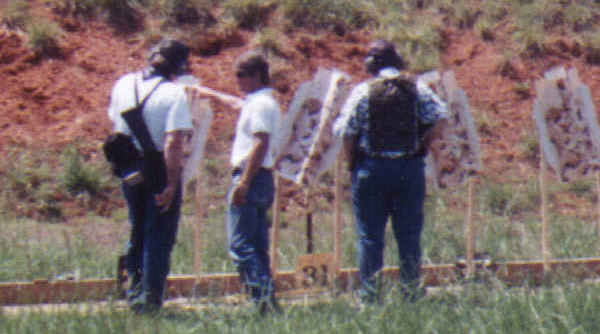
I just finished Louis Awerbuck's Defensive Rifle course. The final day started off with a heck of a bang when one of the AR-15s BLEW ALL OF THE LOCKING LUGS OFF OF ITS BOLT.
A case was left in the chamber, which we of course ASSUMED was from the round that did the damage, but just to be safe, a rod was inserted down another AR-15 with the same barrel length until it touched the bolt face, marked, and then put down the damaged gun to make sure there was no bullet present. And then the case was smacked free with a mallet.
The fella was shooting cheap foreign military surplus stuff, but the consensus was that the ammo was NOT the cause of the major malfunction:
The bolt carrier would NOT lock back or go fully forward, so the upper was removed by punching out both the forward and rear retaining pins. We stopped worrying about that inconvenience after ogling the bolt carrier assembly, but I'm guessing that the buffer broke around the roll pin that retains the rubber stopper which contacts the rear of the tube, allowing various parts (like the little weights that make a clicking noise when you shake a genuine GI full-size buffer) to gum-up the works.
. . .

On the first day we began by sighting-in at 25 and then 50 yards. I think I was the only person (there was a lady in the class, hence the PC formality) who was on at both ranges. So I got to shoot a total of about eight rounds for the first couple of hours while the rest of the class poked and prodded at their knobs and such. First blood was drawn early as a fella with an AR-15 sporting a compact scope walloped the hell out of the bridge of his nose with the Butler Creek flip-up scope cover protecting the rear of the optic. I thought that was real funny until I hurriedly knelt down on a steel 7.62x39mm casing a few hours later. It was standing straight up, and the case mouth gouged me right below the left kneecap. I'm glad I wasn't wearing shorts, as it probably would've punched right through the skin and tore up some important bits. As it was, I hobbled around for the next two days.
If you're thinking about getting a muzzle brake on your sad Post-Ban gun, DON'T! The class goat this time out was a guy I'll refer to as "Greg" because that's his name, who parted the hair and knocked the glasses off anyone within ten feet of his brutal Smith Enterprises blast-spigot (although I must admit that the pain was NOT QUITE as great as that inflicted by his last doohickey, the fearsome AK74-style piece of shit that Bushmaster keeps pushing -- probably because it allows latecomers to buy their 14.5" barrels if the hellish things are permanently arc-welded into place, which pushes the assemblies over the legal limit of 16").
Greg was also the only student with a red-dot sight, a Tasco on one of the "Scout-style" mounts which fit onto the carry handle and place the optic forward over the handguards so that the iron sights can be seen through the glass. The notion here is that if the dot's batteries go, the transition to the back-up sights can be almost instantaneous. Unfortunately, some swizzle-stick at the company decided to ease mounting by making it simpler to rotate the sight 90 degrees by marking the adjustment knobs with "Up/Left -->" or "Up/Right -->" (which would of course depend on the sight's orientation) . . . and Greg guessed wrong. So as Louie was barking-out new sight settings, Mr. G was cranking 'em in bass-ackward. Much merriment ensued.
Two other hard cases were presented by a gent with a Polytech Legend AK47, who performed some radical front-sight windage adjustments with the blunt-end of a hatchet, and the lady student who was having severe left-eye dominance problems. Louie eventually had her switch shoulders, and she did an amazing job with the transition (I seriously doubt if I could've pulled anything like that off!).
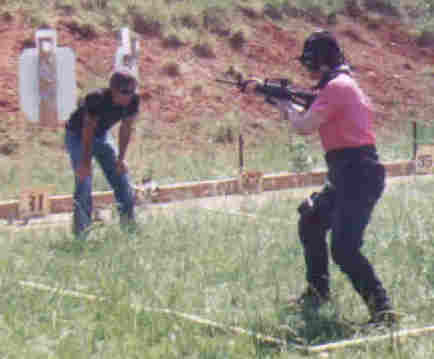
Shortly after the instructor got all the monkeys on the same branch we started shooting at about 25 yards at the special Yavapai Firearms Academy camouflage targets, which can be a bit tricky to hit quickly if you are used to punching only standard black on white bulls and silhouettes. They are even more fun when Awerbuck (or his sidekick Leigh) fold them over cardboard protrusions, tilt, and rotate them to FORCE students to aim center-of-mass at what they are actually being shown.
We soon moved in to close range so that we could work on compensating for boreline/sightline parallax discrepancies (a problem for the AR-15's in particular). Right up close to the paper, we had to aim well over where we actually wanted to hit. Then we immediately went back to about forty yards or so to shoot at a steel plate, and many of the students sailed their rounds high because they were still pulling the same trick . . . which of course was the point.
. . .
On the second day we got to shoot at night. I was the only fella with a flashlight mounted on my gun, which was surprising because when I took Louie's shotgun class the year before most of the students had SureFire dedicated forends on their toys.
My lightweight-barrel AR-15 carbine sported a SureFire 3P with a Z32 spring-loaded shock bezel and S05 pressure switch hose-clamped to the gas tube section of the front site assembly. The S05 (5" in length) cable put the ribbon switch right above the fingers of my support hand when I normally grasped the short CAR handguards, but I soon moved it forward about 3.5" and secured the resulting loop with black electrical tape. This meant that I had to consciously slide my hand up to trigger the light, which beats popping it on by accident. On an AR with full-length handguards, the S05 would be about perfect.
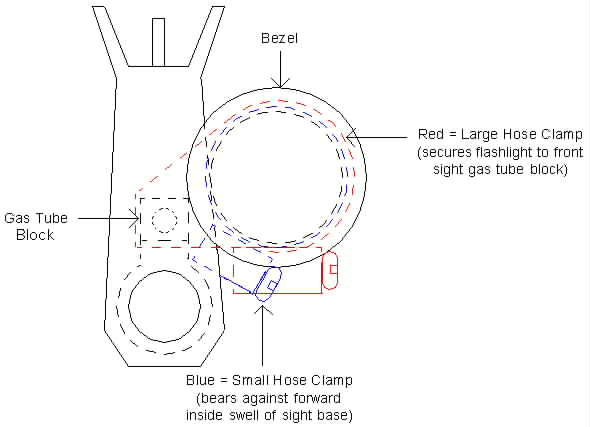
If you plan on doing something similar, pay close attention to the figure shown above. Please notice that the muzzle-end hose clamp (I used an Ideal #20, if your local store carries the same brand) serves exactly TWO purposes: to bear against the rounded forward inside portion of the front sight, and to prevent the light from moving forward under recoil. If you simply attach the light onto the gas block, it can move several degrees up or down -- and it WILL, under recoil -- but using a smaller-head forward clamp forces the light to align with the barrel.
The procedure to follow is:

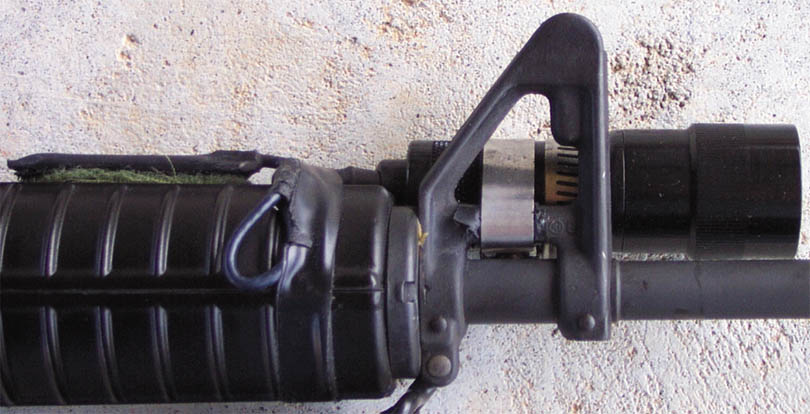
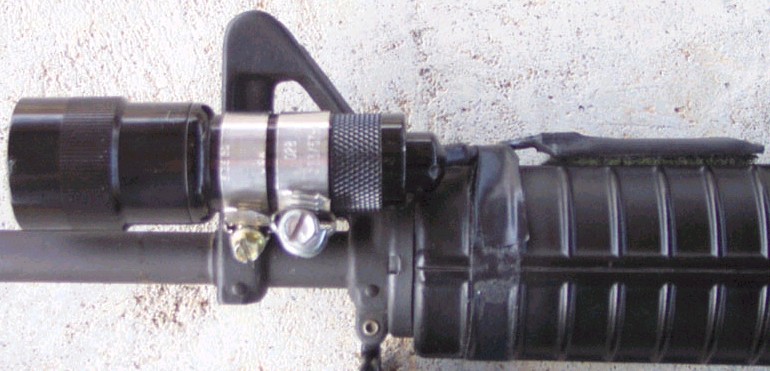
The rest of the students held their lights alongside their forends one way or another, which didn't look too comfortable. My favorite of the alternatives we were shown consisted of forcing the button of a Sure-Fire 6P back against the front of the mag well. The others made it fairly easy to really screw up the alignment between the beam and the barrel.
The Post-Ban owners got to see what they were missing when the night shooting took off in earnest. Big white or yellow or orange balls of flame ripped out of the unenhanced muzzles, which at least had the benefit of really illuminating their targets. Greg's sound enhancer shot up a big pattern of red streaks, which when lit from the side by another student's flashlight looked like high-dollar movie special effects. The three of us who had proper flash hiders produced less light than a Zippo, aside from a few noticeable sparks.
. . .
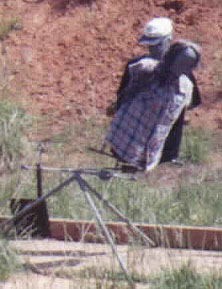
The big fun on the third day was getting to shoot Louie's three-dimensional mover assembly, which consists of a pair of "Tactical Ted" self-sealing head and torso targets mounted via motorcyle shocks onto a tilting and rotating base. Simply by manipulating a pair of control lines, Awerbuck can present just about any sort of target that he wants, with the forward "no-shoot" target usually bobbing-in to obscure the rear "bad guy" target.
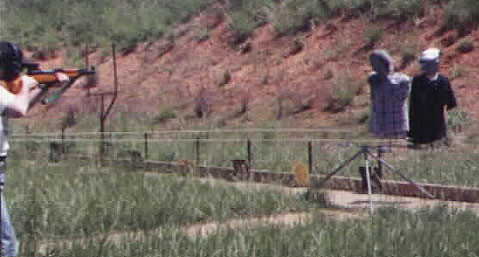
After "Grandma", the no-shoot, got creased a couple of times (and center-punched once or twice), we moved over to do some teamwork exercises. Leigh had layed-out a room for us with lath, as shown below. We were split off into two-member teams and then given about ten minutes to figure out how to make our entrances and work-out our communications. The least complex rule of thumb is that if your partner barks out something loud, it generally means that they've run out of ammo, which Louie ensured by running the pairs until at least one member had gone dry. Folks with HK-style "Team Slings" would then just drop their rifles (which would dangle suspended) and grab their handguns, whereas the rest of us would raise the gun up and ditch them around our necks as we were taught before snatching our pistols. My partner Gary came up with the simple expediency of simply tossing his rifle on the ground, for which he got ridden lightly for the rest of the class.
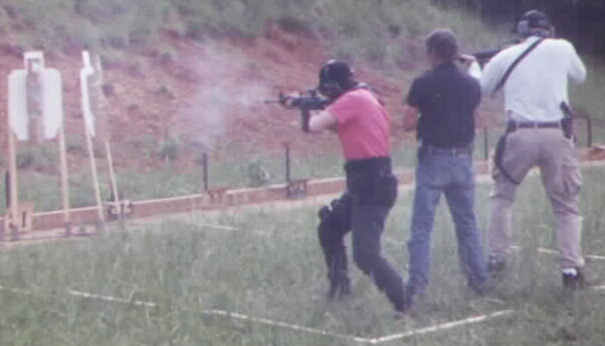
When I took Awerbuck's handgun class two years ago, it snowed. During last year's shotgun class it rained intermittently. We were lucky enough to get three days of beautiful weather this time out, so a swell time was had by all. Except for the fella with the blown-up gun . . .
Oh, and I was the only AR-15 owner who did not have a single failure of any kind. I ran with 55-grain IMI FMJs crimped into military cases over 23.4 grains of AA2200 (ALL DUE WARNINGS REGARDING RELOADED AMMUNITION APPLY HERE!), which I crank out for about seven cents per round. The rest experienced two or more -- and some many -- magazine failures with factory ammo. Almost all were going with 30-rounders, while I used only metal-follower surplus Adventureline 20-rounders. Guess it's a good thing that I grabbed about twenty of them back when they were still $5 each, eh?
Here's another tip: Do NOT fully load your AR mags, as they will be difficult to ram home when the bolt carrier is in battery. The accepted standard is to place 18 in a twenty and 28 in a thirty.
This other guy's PolyTech Legend AK47 variant purred along perfectly, which is what you'd expect, while his brother-in-law who was armed with an SKS created all sorts of problems for himself by failing to jam the ammo from his stripper clips down firmly enough to properly seat the top round. So even a famed example of Russki "idiot-proof" weapon design can fail if the operator is not appropriately trained. Keep that in mind.